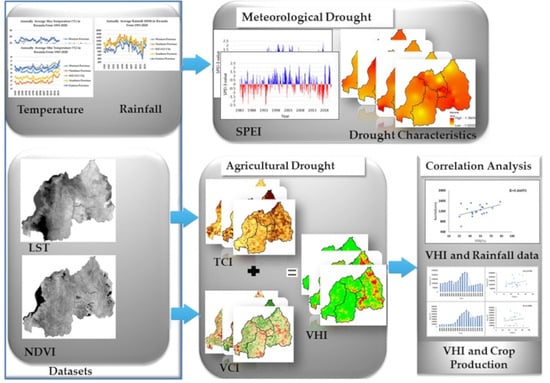Spatiotemporal Analysis of Drought Characteristics and Their Impact on Vegetation and Crop Production in Rwanda
Abstract
:1. Introduction
2. Materials and Methods
2.1. Study Area
2.2. Datasets
2.3. Methods
2.3.1. Standardized Precipitation Evapotranspiration Index (SPEI)
- (1)
- Calculate climate level measurement Di (Equation (1)), which is the difference between precipitation Pi and PETi for the month I as follows:
- (2)
- To calculate the total amount of water available for different periods of time, use the climate water balance series method.
- (3)
- Apply the probability density function of a three-parameter log-logistic distributed variable to fit the data series (Equation (3))
2.3.2. Vegetation Health Index (VHI)
2.3.3. Inverse Distance Weighted (IDW)
2.3.4. Computation of Drought Characteristics
2.3.5. Drought Trend Analysis
2.3.6. Pearson’s Correlation Coefficient
3. Results and Discussion
3.1. The Spatiotemporal Patterns of Meteorological Drought in Rwanda
3.2. Drought Characteristics across Rwandan Provinces
3.3. Drought Trend Analysis Based on SPEI-3
3.4. The Spatiotemporal Patterns of Agriculture Drought in Rwanda
3.4.1. Temperature Conditions and Crop Health: Insights from TCI Analysis
3.4.2. Assessing Vegetation Health and Resilience in Response to Environmental Stressors: A VCI Analysis
3.4.3. Assessing Agricultural Drought Using the Vegetation Health Index
3.4.4. Agricultural Drought (VHI) Response to the Annual Rainfall
3.4.5. The Impact of Agricultural Drought on Crop Production in Rwanda
4. Conclusions
Author Contributions
Funding
Data Availability Statement
Acknowledgments
Conflicts of Interest
References
- Karavitis, C.A.; Tsesmelis, D.E.; Skondras, N.A.; Stamatakos, D.; Alexandris, S.; Fassouli, V.; Vasilakou, C.G.; Oikonomou, P.D.; Gregorič, G.; Grigg, N.S. Linking drought characteristics to impacts on a spatial and temporal scale. Water Policy 2014, 16, 1172–1197. [Google Scholar] [CrossRef]
- Heim, R.R., Jr. A review of twentieth-century drought indices used in the United States. Bull. Am. Meteorol. Soc. 2002, 83, 1149–1166. [Google Scholar] [CrossRef]
- Mishra, A.; Bruno, E.; Zilberman, D. Compound natural and human disasters: Managing drought and COVID-19 to sustain global agriculture and food sectors. Sci. Total Environ. 2021, 754, 142210. [Google Scholar] [CrossRef] [PubMed]
- Ismail, Z.; Go, Y.I. Fog-to-Water for Water Scarcity in Climate-Change Hazards Hotspots: Pilot Study in Southeast Asia. Glob. Chall. 2021, 5, 2000036. [Google Scholar] [CrossRef] [PubMed]
- Wang, D.; Hejazi, M.; Cai, X.; Valocchi, A.J. Climate change impact on meteorological, agricultural, and hydrological drought in central Illinois. Water Resour. Res. 2011, 47, 9. [Google Scholar] [CrossRef]
- Knapp, A.K.; Beier, C.; Briske, D.D.; Classen, A.T.; Luo, Y.; Reichstein, M.; Smith, M.D.; Smith, S.D.; Bell, J.E.; Fay, P.A. Consequences of more extreme precipitation regimes for terrestrial ecosystems. Bioscience 2008, 58, 811–821. [Google Scholar] [CrossRef]
- He, Q.-L.; Xiao, J.-L.; Shi, W.-Y. Responses of Terrestrial Evapotranspiration to Extreme Drought: A Review. Water 2022, 14, 3847. [Google Scholar] [CrossRef]
- Nembilwi, N.; Chikoore, H.; Kori, E.; Munyai, R.B.; Manyanya, T.C. The occurrence of drought in mopani district municipality, South Africa: Impacts, vulnerability and adaptation. Climate 2021, 9, 61. [Google Scholar] [CrossRef]
- Haile, G.G.; Tang, Q.; Sun, S.; Huang, Z.; Zhang, X.; Liu, X. Droughts in East Africa: Causes, impacts and resilience. Earth-Sci. Rev. 2019, 193, 146–161. [Google Scholar] [CrossRef]
- Mullin, M. The effects of drinking water service fragmentation on drought-related water security. Science 2020, 368, 274–277. [Google Scholar] [CrossRef]
- Gatera, Y. Developing Guidelines for the Protection of Cut Slope and Embankment for Roads in Rwanda. Doctoral Dissertation, College of Science and Technology, Phuentsholing, Bhutan, 2021. [Google Scholar]
- REMA. Rwanda State of Environment and Outlook Report; REMA: Kigali, Rwanda, 2009. [Google Scholar]
- Umugwaneza, A.; Chen, X.; Liu, T.; Li, Z.; Uwamahoro, S.; Mind’je, R.; Dufatanye Umwali, E.; Ingabire, R.; Uwineza, A. Future Climate Change Impact on the Nyabugogo Catchment Water Balance in Rwanda. Water 2021, 13, 3636. [Google Scholar] [CrossRef]
- The Ministry of Foreign Affairs of the Netherlands. Climate Change Profile: Rwanda. 2018. Available online: https://www.preventionweb.net/media/92552/download?startDownload=true/ (accessed on 10 July 2023).
- TWB Group. Climate Risk Country Profile: Rwanda. 2021. Available online: https://climateknowledgeportal.worldbank.org/sites/default/files/2021-09/15970-WB_Rwanda%20Country%20Profile-WEB.pdf/ (accessed on 14 May 2023).
- Emmanuel, N. Rwanda’s longest drought in six decades: The effects on food security and lessons learnt. The New Times, 15 September 2016. [Google Scholar]
- Buheji, M.; Muhorakeye, L. Mitigation of drought impact on livestock husbandry. Int. J. Manag. (IJM) 2023, 14, 61–76. [Google Scholar]
- Lydie, M. Droughts and Floodings Implications in Agriculture Sector in Rwanda: Consequences of Global Warming. In The Nature, Causes, Effects and Mitigation of Climate Change on the Environment; IntechOpen: London, UK, 2022. [Google Scholar]
- Ndayisaba, F.; Guo, H.; Bao, A.; Guo, H.; Karamage, F.; Kayiranga, A. Understanding the spatial temporal vegetation dynamics in Rwanda. Remote Sens. 2016, 8, 129. [Google Scholar] [CrossRef]
- Mirindi, J.D. Assessment of the Past and Future Meteorological Drought Characteristics in the Eastern Province of Rwanda Under a Changing Climate. Doctoral Dissertation, University of Nairobi, Nairobi, Kenya, 2022. [Google Scholar]
- Uwimbabazi, J.; Jing, Y.; Iyakaremye, V.; Ullah, I.; Ayugi, B. Observed changes in meteorological drought events during 1981–2020 over Rwanda, East Africa. Sustainability 2022, 14, 1519. [Google Scholar] [CrossRef]
- Henninger, S.M. Does the Global Warming Modify the Local Rwandan Climate? Scientific Research Publishing (SCIRP): Glendale, CA, USA, 2013. [Google Scholar]
- Sebaziga Ndakize, J. Spatial-Temporal Variability and Projected Rainfall over Rwanda. Doctoral Dissertation, University of Rwanda, Kigali, Rwanda, 2018. [Google Scholar]
- Kartika, F.D.; Wijayanti, P. Drought disaster modeling using drought index: A systematic literature review. In IOP Conference Series: Earth and Environmental Science; IOP Publishing: London, UK, 2023. [Google Scholar]
- Vicente-Serrano, S.M.; Beguería, S.; López-Moreno, J.I. A multiscalar drought index sensitive to global warming: The standardized precipitation evapotranspiration index. J. Clim. 2010, 23, 1696–1718. [Google Scholar] [CrossRef]
- Beguería, S.; Vicente-Serrano, S.M.; Reig, F.; Latorre, B. Standardized precipitation evapotranspiration index (SPEI) revisited: Parameter fitting, evapotranspiration models, tools, datasets and drought monitoring. Int. J. Climatol. 2014, 34, 3001–3023. [Google Scholar] [CrossRef]
- Haile, G.G.; Tang, Q.; Leng, G.; Jia, G.; Wang, J.; Cai, D.; Sun, S.; Baniya, B.; Zhang, Q. Long-term spatiotemporal variation of drought patterns over the Greater Horn of Africa. Sci. Total Environ. 2020, 704, 135299. [Google Scholar] [CrossRef]
- Stagge, J.H.; Tallaksen, L.M.; Xu, C.Y.; Van Lanen, H.A. Standardized precipitation-evapotranspiration index (SPEI): Sensitivity to potential evapotranspiration model and parameters. In Hydrology in a Changing World; Copernicus GmbH: Montpellier, France, 2014. [Google Scholar]
- He, J.; Li, B.; Yu, Y.; Sun, L.; Zhang, H.; Malik, I.; Wistuba, M.; Yu, R. Temporal variability of temperature, precipitation and drought indices in hyper-arid region of northwest China for the past 60 years. Atmosphere 2022, 13, 1561. [Google Scholar] [CrossRef]
- Kogan, F.N. Application of vegetation index and brightness temperature for drought detection. Adv. Space Res. 1995, 15, 91–100. [Google Scholar] [CrossRef]
- Kogan, F.N. Global drought watch from space. Bull. Am. Meteorol. Soc. 1997, 78, 621–636. [Google Scholar] [CrossRef]
- Khanmohammadi, F.; Homaee, M.; Noroozi, A.A. Soil moisture estimating with NDVI and land surface temperature and normalized moisture index using MODIS images. J. Water Soil Resour. Conserv. 2015, 4, 37–45. [Google Scholar]
- Pei, F.; Wu, C.; Liu, X.; Li, X.; Yang, K.; Zhou, Y.; Wang, K.; Xu, L.; Xia, G. Monitoring the vegetation activity in China using vegetation health indices. Agric. For. Meteorol. 2018, 248, 215–227. [Google Scholar] [CrossRef]
- Li, Y.; Strapasson, A.; Rojas, O. Assessment of El Niño and La Niña impacts on China: Enhancing the early warning system on food and agriculture. Weather Clim. Extrem. 2020, 27, 100208. [Google Scholar] [CrossRef]
- Kogan, F.; Guo, W.; Strashnaia, A.; Kleshenko, A.; Chub, O.; Virchenko, O. Modelling and prediction of crop losses from NOAA polar-orbiting operational satellites. Geomat. Nat. Hazards Risk 2016, 7, 886–900. [Google Scholar] [CrossRef]
- Haile, G.G.; Tang, Q.; Hosseini-Moghari, S.M.; Liu, X.; Gebremicael, T.; Leng, G.; Kebede, A.; Xu, X.; Yun, X. Projected impacts of climate change on drought patterns over East Africa. Earth’s Future 2020, 8, e2020EF001502. [Google Scholar] [CrossRef]
- Kogan, F. World droughts in the new millennium from AVHRR-based vegetation health indices. Eos Trans. Am. Geophys. Union 2002, 83, 557–563. [Google Scholar] [CrossRef]
- Ajaj, Q.M.; Shareef, M.A.; Hassan, N.D.; Hasan, S.F.; Noori, A.M. GIS based spatial modeling to mapping and estimation relative risk of different diseases using inverse distance weighting (IDW) interpolation algorithm and evidential belief function (EBF) (Case study: Minor Part of Kirkuk City, Iraq). Int. J. Eng. Technol. 2018, 7, 185–191. [Google Scholar] [CrossRef]
- Masroor, K.; Fanaei, F.; Yousefi, S.; Raeesi, M.; Abbaslou, H.; Shahsavani, A.; Hadei, M. Spatial modelling of PM2. 5 concentrations in Tehran using Kriging and inverse distance weighting (IDW) methods. J. Air Pollut. Health 2020, 5, 89–96. [Google Scholar]
- Maleika, W. Inverse distance weighting method optimization in the process of digital terrain model creation based on data collected from a multibeam echosounder. Appl. Geomat. 2020, 12, 397–407. [Google Scholar] [CrossRef]
- Shukla, K.; Kumar, P.; Mann, G.S.; Khare, M. Mapping spatial distribution of particulate matter using Kriging and Inverse Distance Weighting at supersites of megacity Delhi. Sustain. Cities Soc. 2020, 54, 101997. [Google Scholar] [CrossRef]
- Ibrahim, A.M.; Nasser, R.H.A. Comparison between inverse distance weighted (IDW) and Kriging. Int. J. Sci. Res. 2015, 6, 2319–7064. [Google Scholar]
- Ankrah, J.; Monteiro, A.; Madureira, H. Spatiotemporal Characteristics of Meteorological Drought and Wetness Events across the Coastal Savannah Agroecological Zone of Ghana. Water 2023, 15, 211. [Google Scholar] [CrossRef]
- Mann, H.B. Nonparametric tests against trend. Econom. J. Econom. Soc. 1945, 13, 245–259. [Google Scholar] [CrossRef]
- Kendall, M.G. Rank Correlation Methods. J. Inst. Actuar. 1948. [Google Scholar] [CrossRef]
- Cohen, I.; Huang, Y.; Chen, J.; Benesty, J.; Benesty, J.; Chen, J.; Huang, Y.; Cohen, I. Pearson correlation coefficient. In Noise Reduction in Speech Processing; Springer: Berlin/Heidelberg, Germany, 2009; pp. 1–4. [Google Scholar]
- Emerson, R.W. Causation and Pearson’s correlation coefficient. J. Vis. Impair. Blind. 2015, 109, 242–244. [Google Scholar] [CrossRef]
- Ishfaq, U.; Khan, H.U.; Iqbal, K. Modeling to find the top bloggers using sentiment features. In Proceedings of the IEEE 2016 International Conference on Computing, Electronic and Electrical Engineering (ICE Cube), Quetta, Pakistan, 11–12 April 2016. [Google Scholar]
- Cook, B.I.; Smerdon, J.E.; Seager, R.; Coats, S. Global warming and 21 st century drying. Clim. Dyn. 2014, 43, 2607–2627. [Google Scholar] [CrossRef]
- Safari, B.; Sebaziga, J.N. Trends and Variability in Temperature and Related Extreme Indices in Rwanda during the Past Four Decades. Atmosphere 2023, 14, 1449. [Google Scholar] [CrossRef]
- Chang’a, L.B.; Kijazi, A.L.; Luhunga, P.M.; Ng’ongolo, H.K.; Mtongori, H.I. Spatial and temporal analysis of rainfall and temperature extreme indices in Tanzania. Atmos. Clim. Sci. 2017, 7, 525–539. [Google Scholar] [CrossRef]
- Ndayiragije, J.M.; Li, F. Monitoring and analysis of drought characteristics based on climate change in Burundi using standardized precipitation evapotranspiration index. Water 2022, 14, 2511. [Google Scholar] [CrossRef]
- Pachauri, R.K.; Allen, M.R.; Barros, V.R.; Broome, J.; Cramer, W.; Christ, R.; Church, J.A.; Clarke, L.; Dahe, Q.; Dasgupta, P. Climate Change 2014: Synthesis Report. Contribution of Working Groups I, II and III to the Fifth Assessment Report of the Intergovernmental Panel on Climate Change; IPCC: Geneva, Switzerland, 2014. [Google Scholar]
- Dai, A. Future warming patterns linked to today’s climate variability. Sci. Rep. 2016, 6, 19110. [Google Scholar] [CrossRef]
- Lyon, B. Seasonal drought in the Greater Horn of Africa and its recent increase during the March–May long rains. J. Clim. 2014, 27, 7953–7975. [Google Scholar] [CrossRef]
- Twahirwa, A.; Oludhe, C.; Omondi, P.; Rwanyiziri, G.; Sebaziga Ndakize, J. Assessing Variability and Trends of Rainfall and Temperature for the District of Musanze in Rwanda. Adv. Meteorol. 2023, 2023, 7177776. [Google Scholar] [CrossRef]
- Kalisa, W.; Zhang, J.; Igbawua, T.; Ujoh, F.; Ebohon, O.J.; Namugize, J.N.; Yao, F. Spatio-temporal analysis of drought and return periods over the East African region using Standardized Precipitation Index from 1920 to 2016. Agric. Water Manag. 2020, 237, 106195. [Google Scholar] [CrossRef]
- Zeng, J.; Zhang, R.; Qu, Y.; Bento, V.A.; Zhou, T.; Lin, Y.; Wu, X.; Qi, J.; Shui, W.; Wang, Q. Improving the drought monitoring capability of VHI at the global scale via ensemble indices for various vegetation types from 2001 to 2018. Weather Clim. Extrem. 2022, 35, 100412. [Google Scholar] [CrossRef]
- Gidey, E.; Dikinya, O.; Sebego, R.; Segosebe, E.; Zenebe, A. Analysis of the long-term agricultural drought onset, cessation, duration, frequency, severity and spatial extent using Vegetation Health Index (VHI) in Raya and its environs, Northern Ethiopia. Environ. Syst. Res. 2018, 7, 1–18. [Google Scholar] [CrossRef]
- Gomes, A.R.d.S.; Alves, J.M.B.; Silva, E.M.d.; Gomes, M.R.d.S.; Gomes, C.R.d.S. Study of the Relationship Between the Variability of Vegetation and Temperature Indexes of the Northeast Region of Brazil. Rev. Bras. De Meteorol. 2019, 34, 359–368. [Google Scholar] [CrossRef]
- Li, Y.; Zhao, Z.; Wang, L.; Li, G.; Chang, L.; Li, Y. Vegetation changes in response to climatic factors and human activities in Jilin Province, China, 2000–2019. Sustainability 2021, 13, 8956. [Google Scholar] [CrossRef]
- Zhang, B.; Zhu, J.-J.; Liu, H.-M.; Pan, Q.-M. Effects of extreme rainfall and drought events on grassland ecosystems. Chin. J. Plant Ecol. 2014, 38, 1008. [Google Scholar]
- Dutta, D.; Kundu, A.; Patel, N.; Saha, S.; Siddiqui, A. Assessment of agricultural drought in Rajasthan (India) using remote sensing derived Vegetation Condition Index (VCI) and Standardized Precipitation Index (SPI). Egypt. J. Remote Sens. Space Sci. 2015, 18, 53–63. [Google Scholar] [CrossRef]
- Ait Ayad, N.; Ait Ayad, A.; El Khalidi, K.; Habib, A.; Charif, A. Remote sensing and meteorological indexes of drought using open short time-series data in Doukkala Region, Morocco. Ecol. Eng. Environ. Technol. 2023, 24, 1–10. [Google Scholar] [CrossRef]
- Kogan, F.N. Remote sensing of weather impacts on vegetation in non-homogeneous areas. Int. J. Remote Sens. 1990, 11, 1405–1419. [Google Scholar] [CrossRef]
- Lima, S.C.d.; Moraes Neto, J.M.d.; Lima, J.P.; Lima, F.C.d.; Saboya, L.M. Response of semi-arid vegetation to agricultural drought determined by indices derived from MODIS satellite. Rev. Bras. De Eng. Agrícola E Ambient. 2023, 27, 632–642. [Google Scholar] [CrossRef]
- Ahmed, S.M. Impacts of drought, food security policy and climate change on performance of irrigation schemes in Sub-saharan Africa: The case of Sudan. Agric. Water Manag. 2020, 232, 106064. [Google Scholar] [CrossRef]
- Manatsa, D.; Mukwada, G.; Siziba, E.; Chinyanganya, T. Analysis of multidimensional aspects of agricultural droughts in Zimbabwe using the Standardized Precipitation Index (SPI). Theor. Appl. Climatol. 2010, 102, 287–305. [Google Scholar] [CrossRef]
- Cao, S.; Zhang, L.; He, Y.; Zhang, Y.; Chen, Y.; Yao, S.; Yang, W.; Sun, Q. Effects and contributions of meteorological drought on agricultural drought under different climatic zones and vegetation types in Northwest China. Sci. Total Environ. 2022, 821, 153270. [Google Scholar] [CrossRef] [PubMed]
- Lottering, S.; Mafongoya, P.; Lottering, R. Drought and its impacts on small-scale farmers in sub-Saharan Africa: A review. S. Afr. Geogr. J. 2021, 103, 319–341. [Google Scholar] [CrossRef]
- Wan, Z.; Wang, P.; Li, X. Using MODIS land surface temperature and normalized difference vegetation index products for monitoring drought in the southern Great Plains, USA. Int. J. Remote Sens. 2004, 25, 61–72. [Google Scholar] [CrossRef]
- Kloos, S.; Yuan, Y.; Castelli, M.; Menzel, A. Agricultural drought detection with MODIS based vegetation health indices in southeast Germany. Remote Sens. 2021, 13, 3907. [Google Scholar] [CrossRef]
- Grigorieva, E.; Livenets, A.; Stelmakh, E. Adaptation of Agriculture to Climate Change: A Scoping Review. Climate 2023, 11, 202. [Google Scholar] [CrossRef]
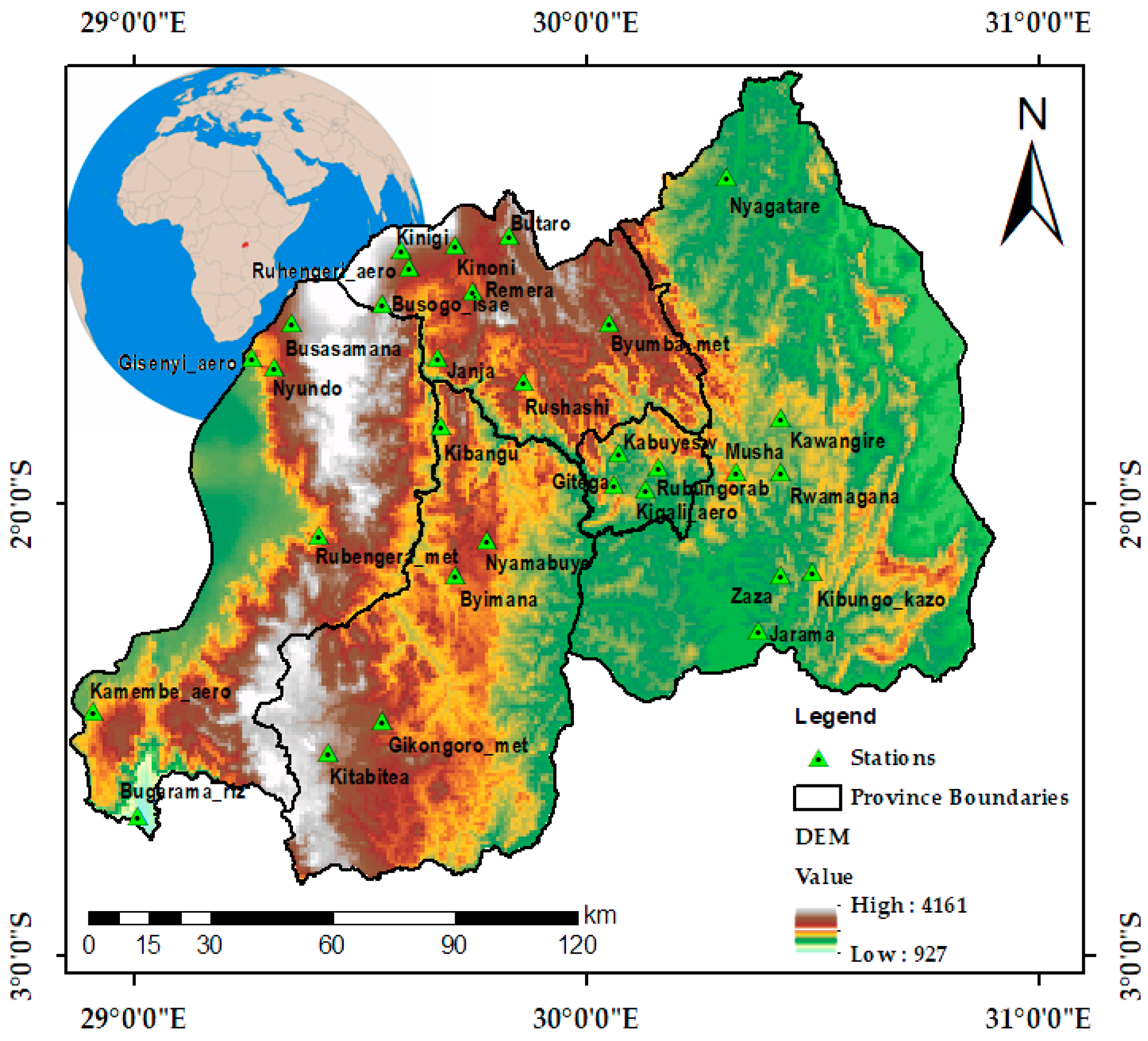

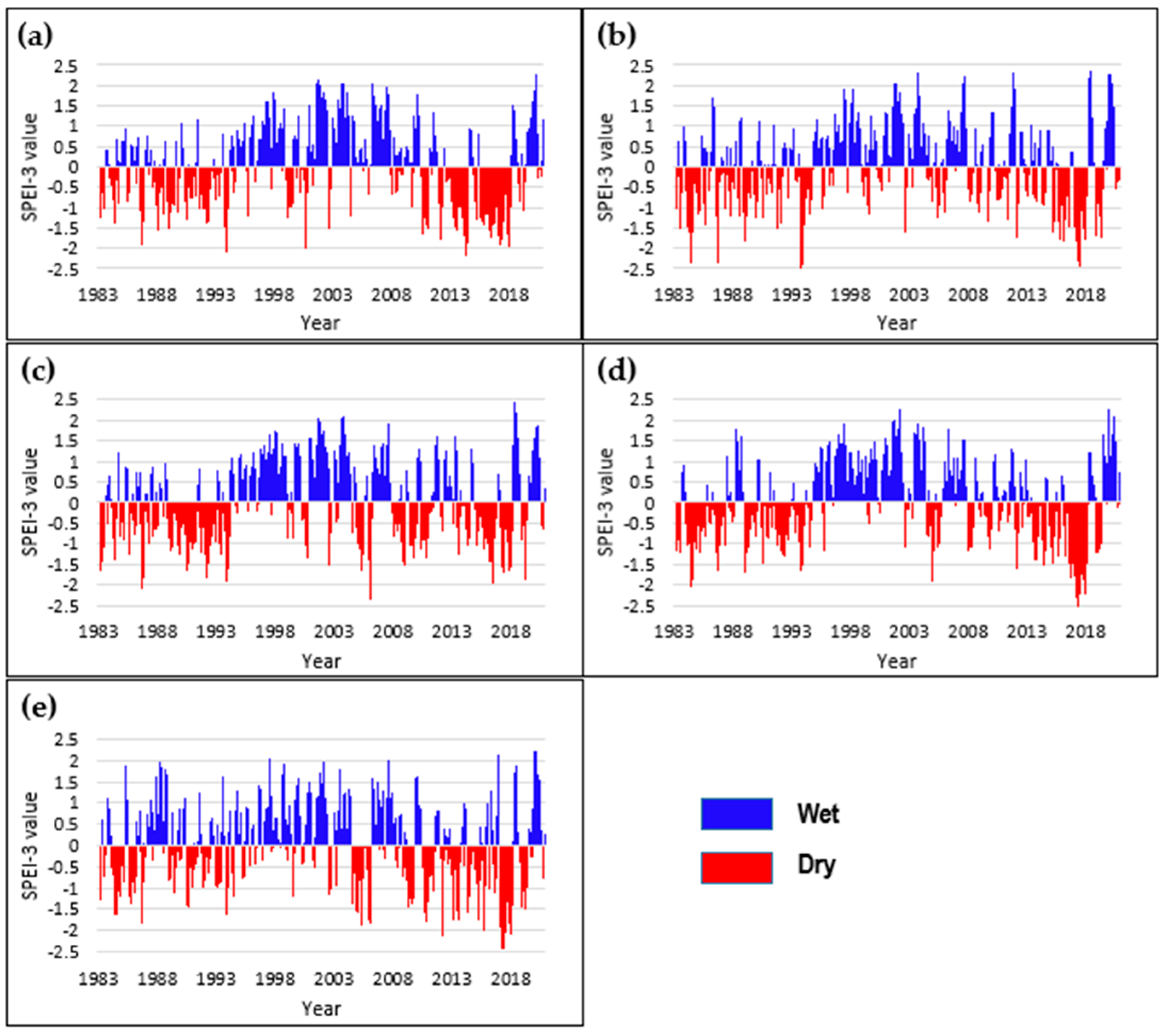

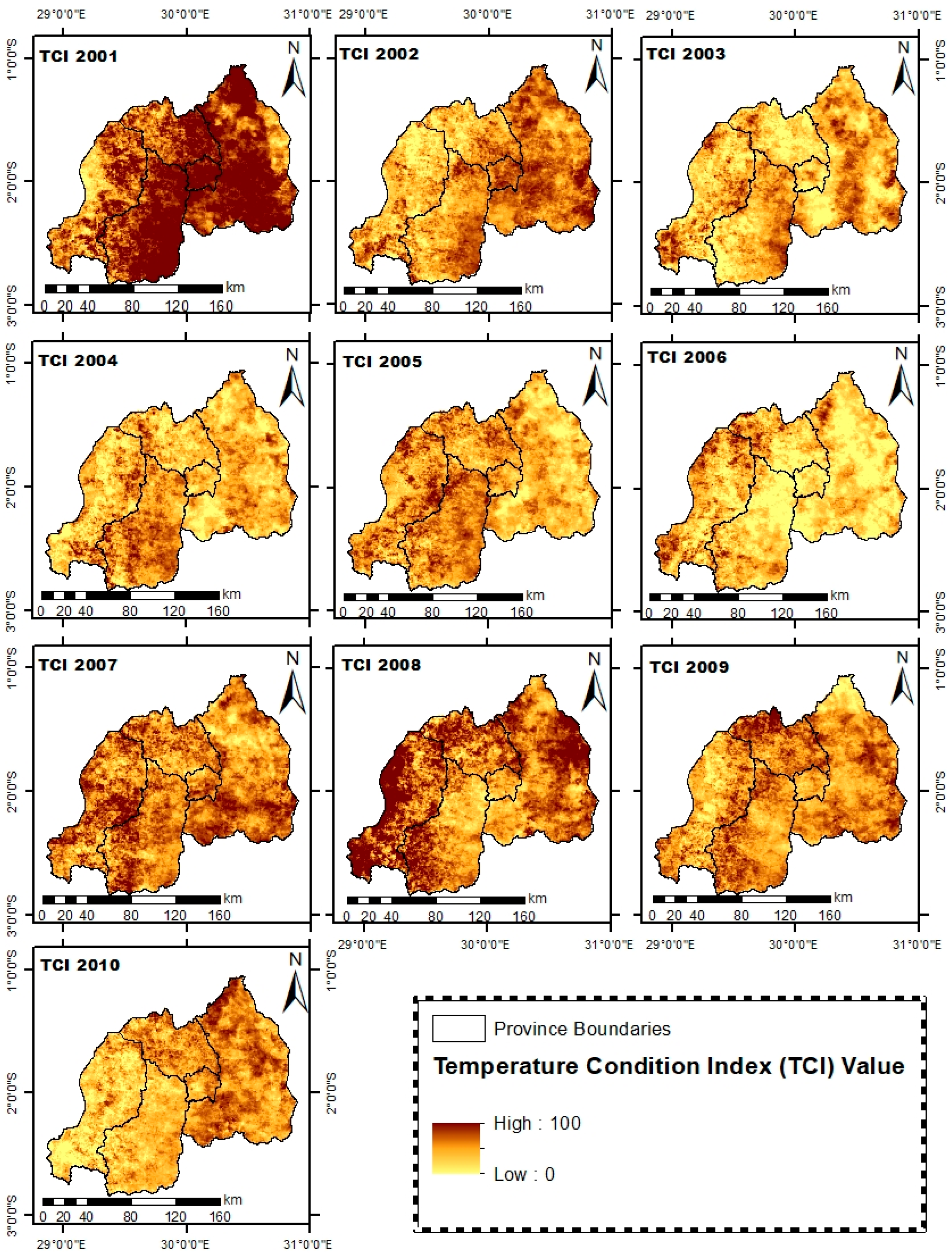
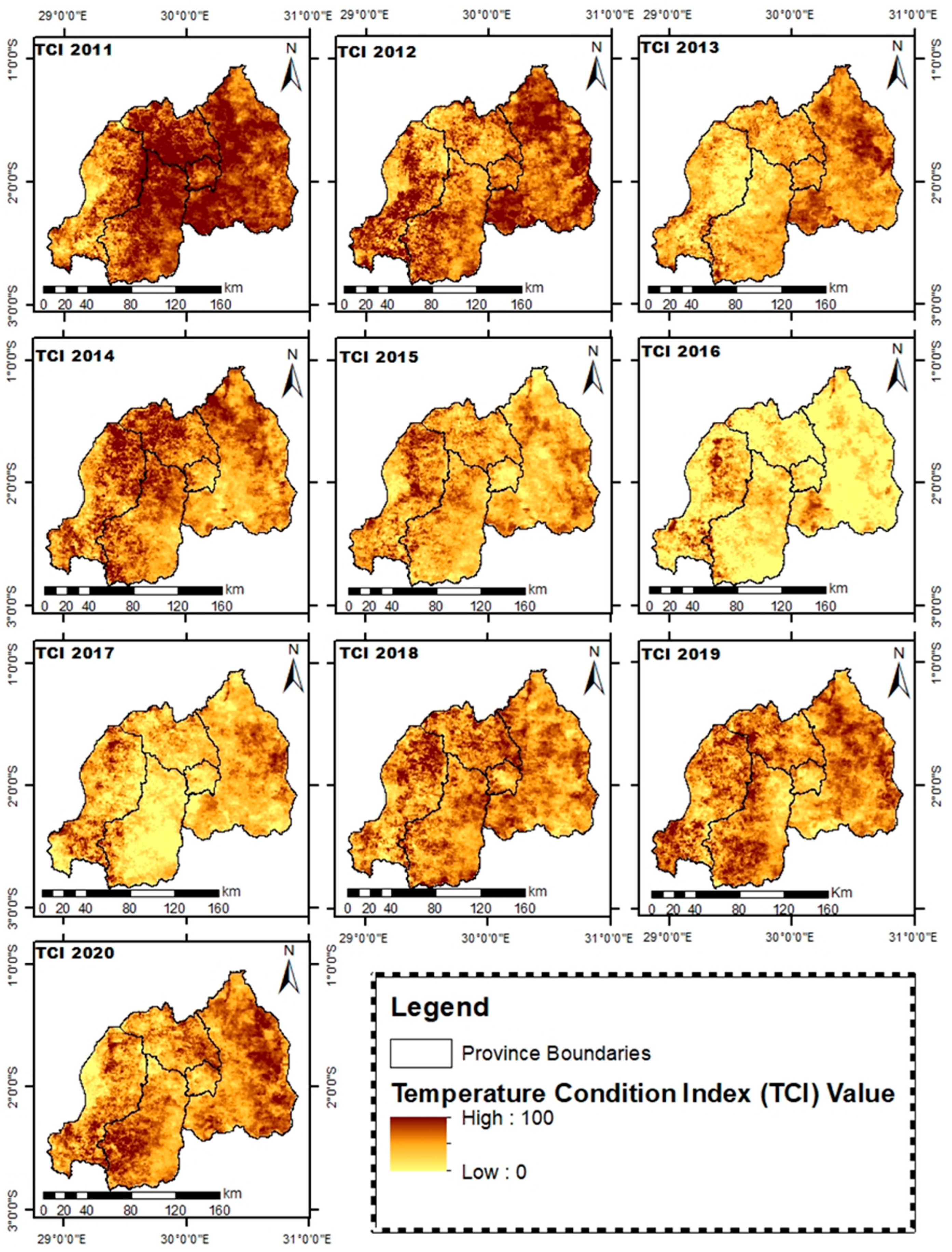
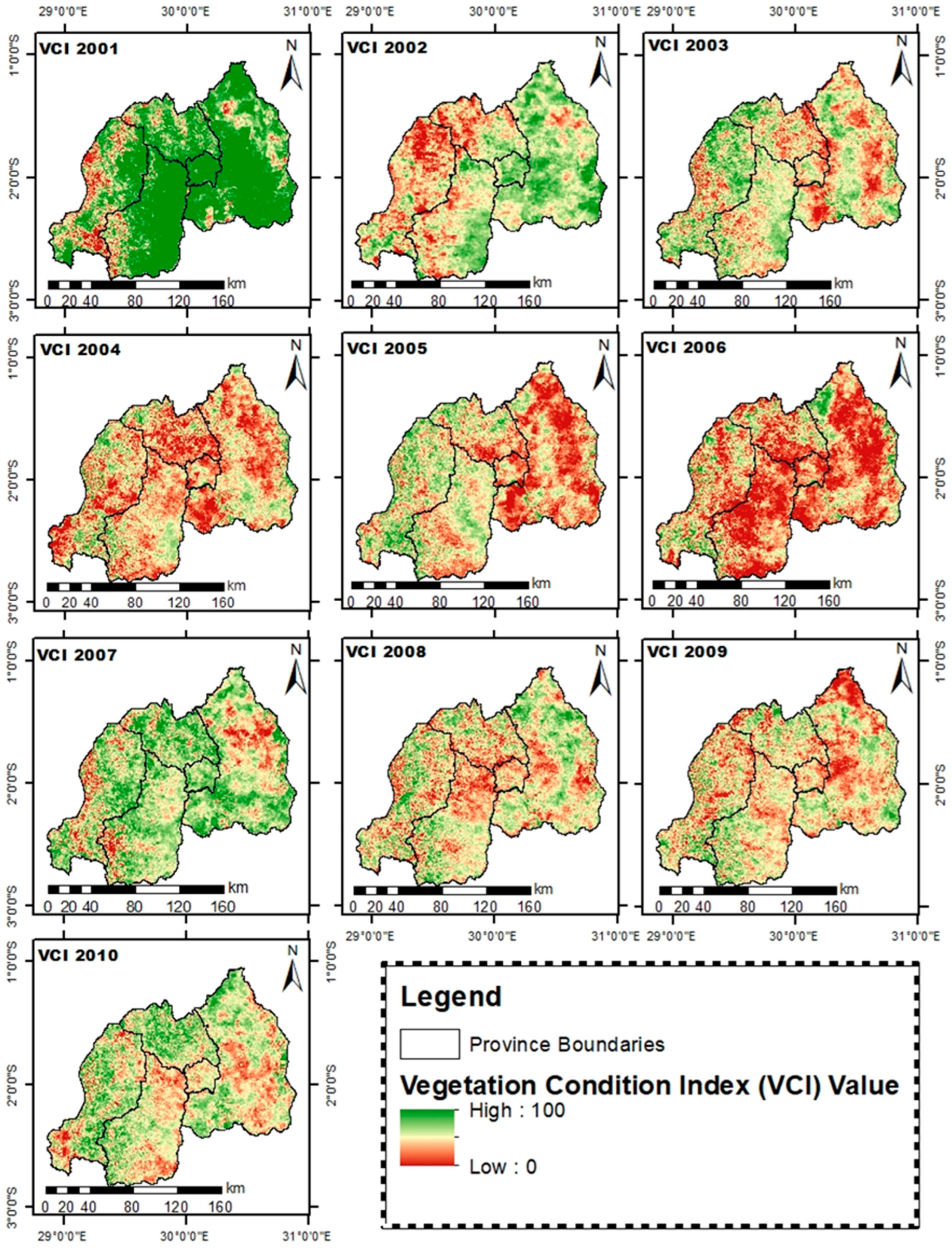



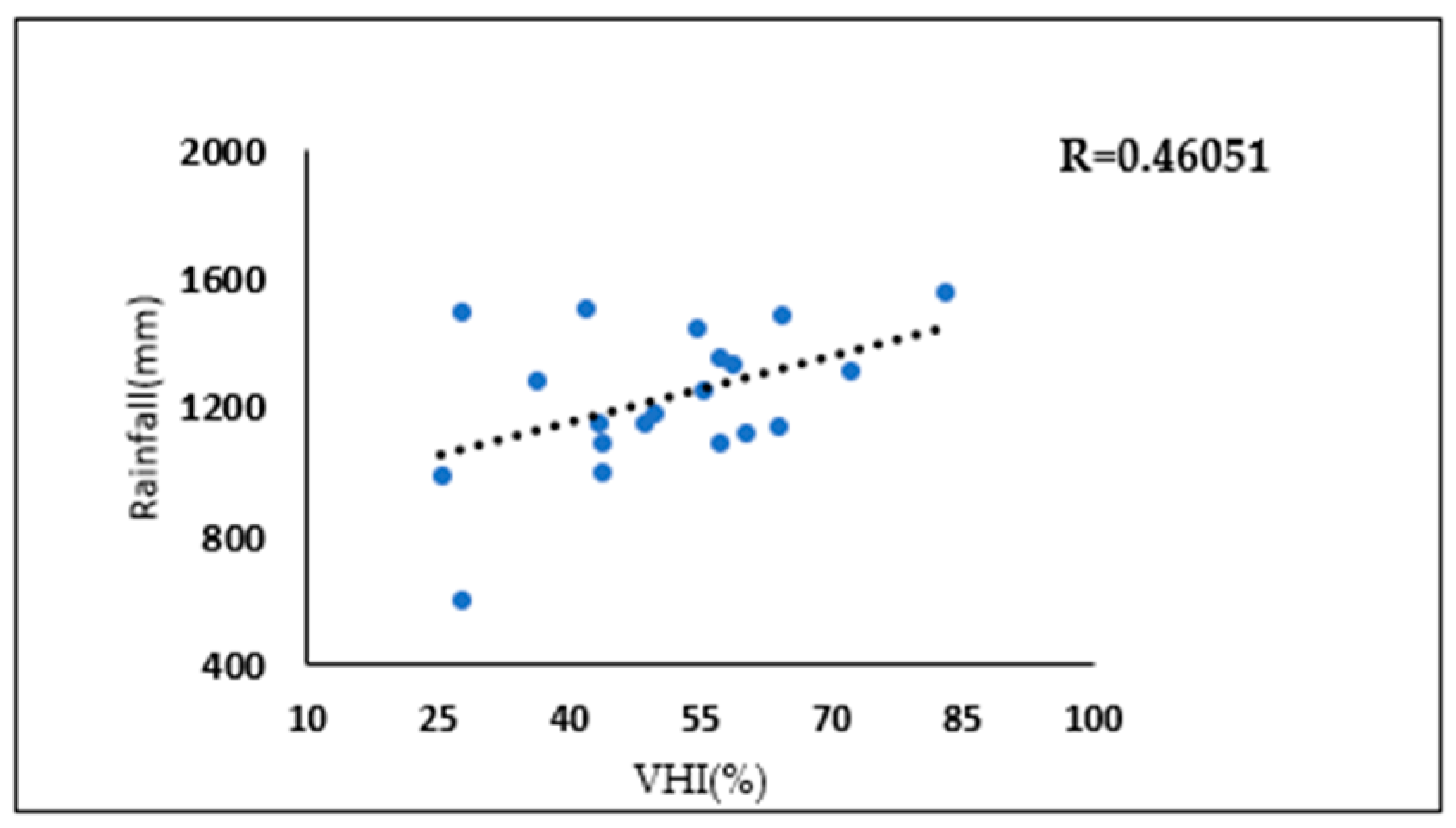

| Grade | Types | SPEI | VHI (%) |
|---|---|---|---|
| 1 | No drought | SPEI > −1 | VHI > 40 |
| 2 | Mild drought | - | 30 ≤ VHI < 40 |
| 3 | Moderate drought | −1.5 < SPEI ≤ −1 | 20 ≤ VHI < 30 |
| 4 | Severe drought | −2 < SPEI ≤ −1.5 | 10 ≤ VHI < 20 |
| 5 | Extreme drought | SPEI ≤ −2 | VHI < 10 |
| Drought Characteristics | Equation | Symbol and Units |
|---|---|---|
| Drought duration (D) | D: drought duration (months), di: duration of an ith drought event, n: total number of drought events | |
| Drought frequency (F) | F: drought frequency (%), nm: number of drought months, Nm: total number of months | |
| Drought severity (S) | S: drought severity | |
| Drought intensity (I) | I: drought intensity (−), n: number of drought occurrences in months with SPEI < −1, SPEIi: SPEI value under the threshold (−) |
Disclaimer/Publisher’s Note: The statements, opinions and data contained in all publications are solely those of the individual author(s) and contributor(s) and not of MDPI and/or the editor(s). MDPI and/or the editor(s) disclaim responsibility for any injury to people or property resulting from any ideas, methods, instructions or products referred to in the content. |
© 2024 by the authors. Licensee MDPI, Basel, Switzerland. This article is an open access article distributed under the terms and conditions of the Creative Commons Attribution (CC BY) license (https://creativecommons.org/licenses/by/4.0/).
Share and Cite
Niyonsenga, S.; Eziz, A.; Kurban, A.; Yuan, X.; Umwali, E.D.; Azadi, H.; Hakorimana, E.; Umugwaneza, A.; Fidelis, G.D.; Nsanzabaganwa, J.; et al. Spatiotemporal Analysis of Drought Characteristics and Their Impact on Vegetation and Crop Production in Rwanda. Remote Sens. 2024, 16, 1455. https://doi.org/10.3390/rs16081455
Niyonsenga S, Eziz A, Kurban A, Yuan X, Umwali ED, Azadi H, Hakorimana E, Umugwaneza A, Fidelis GD, Nsanzabaganwa J, et al. Spatiotemporal Analysis of Drought Characteristics and Their Impact on Vegetation and Crop Production in Rwanda. Remote Sensing. 2024; 16(8):1455. https://doi.org/10.3390/rs16081455
Chicago/Turabian StyleNiyonsenga, Schadrack, Anwar Eziz, Alishir Kurban, Xiuliang Yuan, Edovia Dufatanye Umwali, Hossein Azadi, Egide Hakorimana, Adeline Umugwaneza, Gift Donu Fidelis, Justin Nsanzabaganwa, and et al. 2024. "Spatiotemporal Analysis of Drought Characteristics and Their Impact on Vegetation and Crop Production in Rwanda" Remote Sensing 16, no. 8: 1455. https://doi.org/10.3390/rs16081455
APA StyleNiyonsenga, S., Eziz, A., Kurban, A., Yuan, X., Umwali, E. D., Azadi, H., Hakorimana, E., Umugwaneza, A., Fidelis, G. D., Nsanzabaganwa, J., & Nzabarinda, V. (2024). Spatiotemporal Analysis of Drought Characteristics and Their Impact on Vegetation and Crop Production in Rwanda. Remote Sensing, 16(8), 1455. https://doi.org/10.3390/rs16081455







